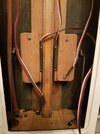The motor/engine part was more of a CYA just in case you had posted incorrectly about what/which you were using.
The RX is a negligible part of the equation of power usage. While they do use a certain amount depending on what power level they are set for ( country dependent since the laws for the allowed power levels differ ), it isn't a big amount. Since different makes/models will likely differ slightly, it would be a spec you'd want to look up for the specific one you are using.
Servo's are also going to be unique on the amount of draw they are capable of which is why I said you'd want to look that up based on the make/model you are using. Even similar sized ones have different torque and/or speed values and therefor will also have different power draws. This is why I said this is the part you want to look up and pay attention to.
The part I forgot to bring up would be how the power is supplied and what it is capable of. I'm not even sure why/how I overlooked that part. Direct from a battery pack and what it can supply, will differ from an ESC ( irrelevant since you aren't using a motor, just included for others that may read this later ) can provide vs a BEC. I think most of the BEC's I've seen specs on list having either 3A, 5A or 10A of current and of course there are now different voltages they can provide with the advent of high power servos being a thing now.

 And if you look up the definition, they interchange, but that is an argument for another day. That was NOT the purpose of my query. I was trying to establish a basis for it. A .21 boat will not nearly have the stress on the rudder servo that a .90 boat will.
And if you look up the definition, they interchange, but that is an argument for another day. That was NOT the purpose of my query. I was trying to establish a basis for it. A .21 boat will not nearly have the stress on the rudder servo that a .90 boat will.![20211107_230740[1].jpg](/data/attachments/19/19556-bc9d7711996f0c9ad34f2e4f049158ee.jpg)


